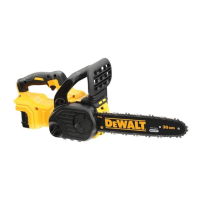16
ENGLISH
use the retreat path planned. Be alert for overhead limbs
falling and watch yourfooting.
51mm
DIRECTION OF FALL
51mm
HINGE
NOTCH
FELLING BACK CUT
Limbing
Removing the branches from a fallen tree. When limbing, leave
larger lower limbs to support the log off the ground. Remove
the small limbs in one cut. Branches under tension should be
cut from the bottom of the branch towards the top to avoid
binding the chainsaw as shown below. Trim limbs from opposite
side keeping tree stem between you and saw. Never make cuts
with saw between your legs or straddle the limb to becut.
Bucking
WARNING: Recommend that first time users should
practice cutting on a sawhorse.
Cutting a felled tree or log into lengths. How you should
cut depends on how the log is supported. Use a saw horse
wheneverpossible as shownbelow.
1. Always start a cut with the saw chain running at fullspeed.
2. Place the bottom spike
23
of the chainsaw behind the area
of the initial cut as shownbelow.
3. Turn the chainsaw on then rotate the saw chain and bar
down into the tree, using the spike as ahinge.
Common Cutting Techniques
Felling
The process of cutting down a tree. Do not fell trees in high
windconditions.
WARNING: Felling can result in injury. It should only be
performed by a trainedperson.
• A retreat path should be planned and cleared as necessary
before cuts are started. The retreat path should extend back
and diagonally to the rear of the expected line of fall as
shownbelow.
DIRECTION
OF
FALL
RETREAT
45°
TREE
45°
RETREAT
• Before felling is started, consider the natural lean of the
tree, the location of larger branches and the wind direction
to judge which way the tree will fall. Have wedges (wood,
plastic or aluminum) and a heavy mallet handy. Remove
dirt, stones, loose bark, nails, staples, and wire from the tree
where the felling cuts are to bemade.
• Notching Undercut - Make the notch 1/3 of the diameter
of the tree, perpendicular to the direction of the fall. Make
the lower horizontal notching cut first. This will help to avoid
pinching of either the saw chain or the guide bar when the
second notch cut is being made as shownbelow.
• Felling Back Cut - Make the felling back cut at least 51mm
higher than the horizontal notching cut. Keep the felling
back cut parallel to the horizontal notching cut. Make the
felling back cut so enough wood is left to act as a hinge.
The hinge wood keeps the tree from twisting and falling
in the wrong direction. Do not cut through the hinge as
shownbelow.
• As the felling cut gets close to the hinge the tree should
begin to fall. If there is any chance that the tree may not fall
in the desired direction or it may rock back and bind the saw
chain, stop cutting before the felling cut is complete and use
wedges to open the cut and drop the tree along the desired
line of fall. When the tree begins to fall remove the chainsaw
from the cut, stop the motor, put the chainsaw down, then
2. In order to keep the unit running you must continue to
squeeze the trigger. To turn the unit off, release thetrigger.
NOTE: If too much force is applied while making a cut the
saw will turn off. To restart saw, you must release the trigger
switch
1
before the saw will restart. Begin your cut again this
time with less force. Allow the saw to cut at its ownpace.
WARNING: Never attempt to lock a switch in the
ONposition.

